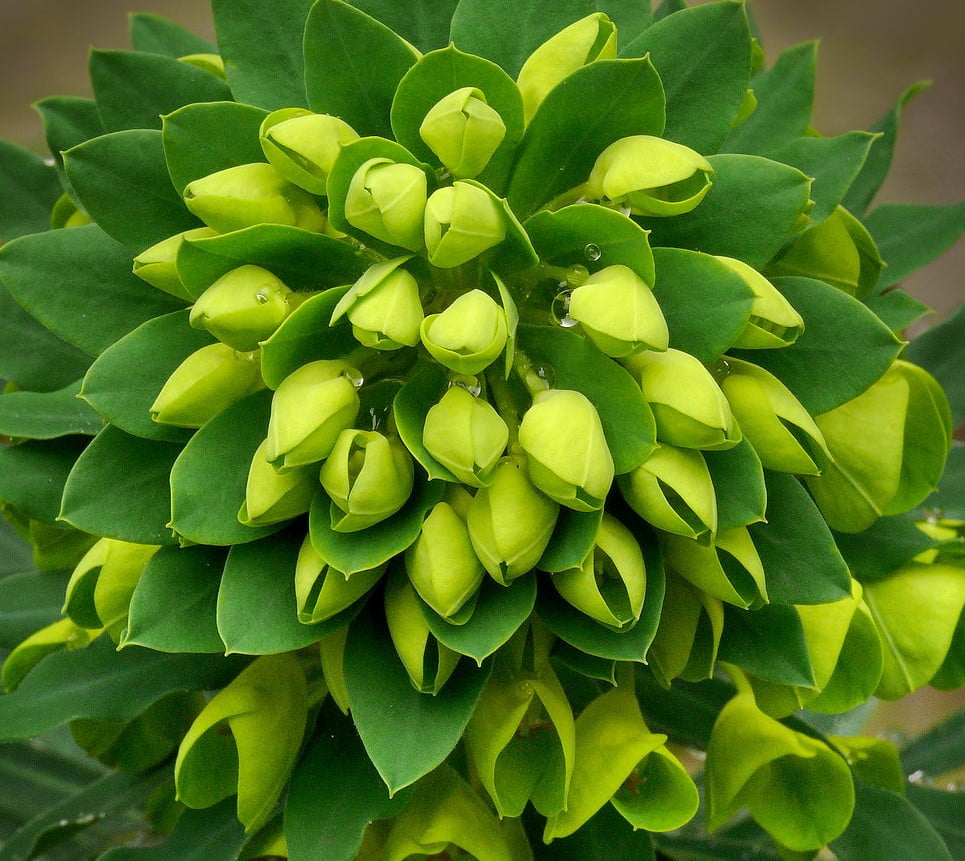The Ultimate Euphorbia Characias Care Guide: Flourishing Mediterranean Spurge in Your Garden
The Euphorbia Characias is a beautiful shrub that blooms from late winter to early summer. It has yellow bracts that look like flowers. It is also known as the Mediterranean spurge.
Euphorbia Characias is a plant that grows well in warm climates. It can withstand drought and thrive in poor soils. Because of these qualities, it is an excellent choice for xeriscaping.
Growing plants is relatively easy, but they require specific care. To keep plants healthy, you need to plant them properly, water them regularly, give them enough sunlight, prune them, and prevent pests.
This guide covers everything required for growing Euphorbia Characias. It includes:
Optimal conditions
Step-by-step planting
Ongoing care and maintenance
Propagation techniques
Troubleshooting common problems
Follow these tips to enjoy Mediterranean spurge’s elegance in your garden. With the right care, it will reward you with years of striking blooms and handsome structure.
Key Takeaways:
Full sun exposure
Well-draining soil
Moderate watering
Fertilize during growing season
Prune back spent blooms
Monitor for pests
Protect roots from winter cold
Easy propagation from cuttings
Optimal Growing Conditions for Euphorbia Characias
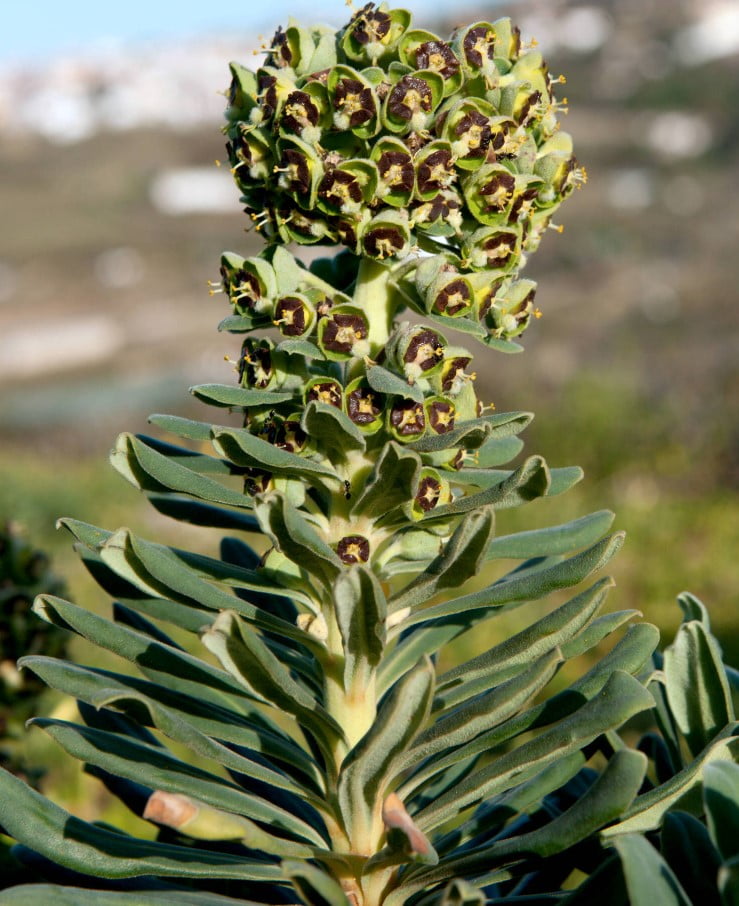
Euphorbia Characias thrives when provided with proper growing conditions. Here are the key factors to consider:
Sunlight
Euphorbia Characias requires full sun for optimal growth and flowering.
It should receive at least 6-8 hours of direct sunlight per day.
Insufficient sunlight can result in reduced blooms and leggy growth.
In very hot climates, provide some afternoon shade to prevent leaf scorch.
USDA Hardiness Zones
Euphorbia Characias grows best in USDA hardiness zones 9-11.
It can be grown as an annual in zones 8 and below.
Mature plants can tolerate brief dips to 15-20°F when well-established.
Protect from frost and freezing temperatures below 30°F.
Soil
Well-draining sandy or loamy soil is ideal.
Amend heavy clay soils with gravel, sand or compost to improve drainage.
A soil pH between 6.0-7.0 is preferred, but Euphorbia Characias tolerates a wide pH range.
Avoid wet, poorly draining sites prone to waterlogging.
Watering
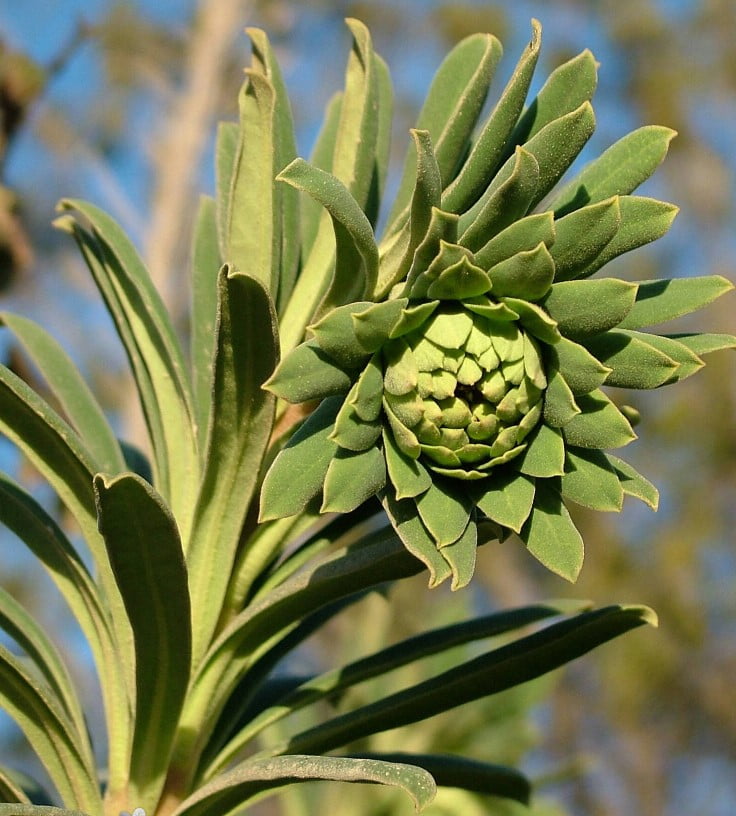
Water 1-2 times per week after planting until roots establish.
Mature plants are quite drought tolerant and need occasional watering.
Allow soil to partially dry out between waterings.
Overwatering can lead to root rot.
Temperature
Daytime temperatures of 60-85°F are optimal.
Can tolerate highs up to 100°F for short periods.
Cannot withstand frost or freezing below 30°F.
Humidity
Prefers 40-60% humidity levels.
Avoid excessively dry or humid conditions.
Good air circulation is beneficial.
Providing the ideal growing conditions encourages healthy Euphorbia Characias growth and prolific flowering. Pay close attention to sunlight, soil drainage, watering, and protection from frost.
How to Plant Euphorbia Characias
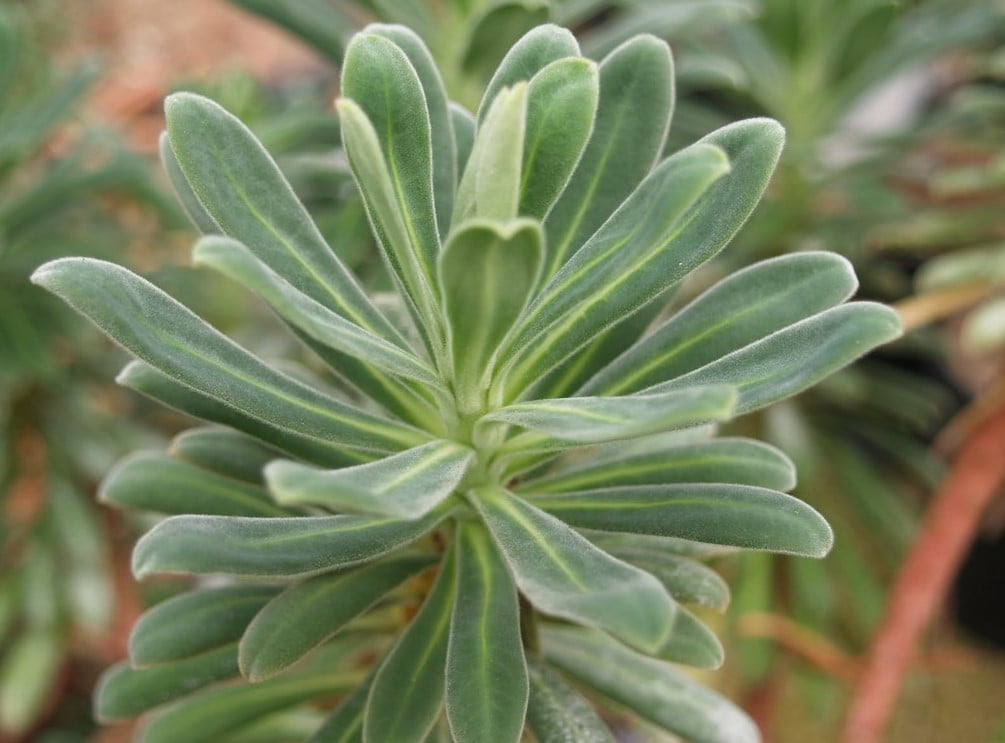
Euphorbia Characias can be grown from seed or transplanted from nursery plants. Follow these tips for successful planting:
Starting from Seeds
Start Euphorbia seeds indoors 6-8 weeks before the last expected spring frost[1]. Use small pots with seed starting mix.
Barely cover the seeds with soil, as light is needed for germination[2]. Maintain a temperature of 65-75°F[3].
Once sprouted, grow seedlings under grow lights with 14-16 hours of daily light. Gradually harden off for 7-10 days before transplanting outside after danger of frost has passed[4].
Transplanting from Nursery Plants
Purchase young Euphorbia plants from a reputable nursery in spring, selecting healthy plants with no root damage[5].
Prepare the planting area in full sun with well-draining soil amended with compost[3].
Space transplants 18-24 inches apart[6]. Dig holes the same depth as root balls and 2-3 times wider.
Carefully remove plants from containers, loosen any circling roots, place in hole and backfill with native soil[3].
Water thoroughly after planting and add 2-3 inches of organic mulch around the base[4].
Aftercare
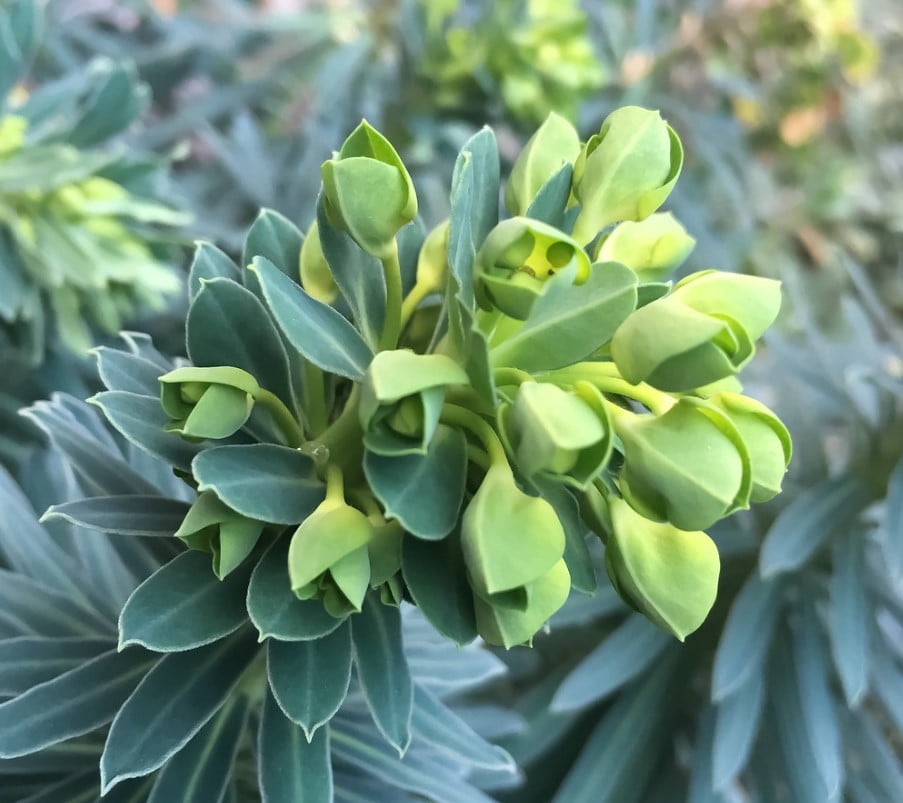
Water transplants 1-2 times per week during the first growing season if rainfall is less than 1 inch per week[3].
Fertilize monthly with a balanced organic fertilizer during the first year[4].
Reduce watering frequency after plants become established, usually by second year.
Proper planting and aftercare provides Euphorbia Characias with the best start. Be sure to harden off any indoor started plants before transplanting outside.
Ongoing Care and Maintenance for Euphorbia Characias
With proper ongoing care, Euphorbia Characias will continue thriving for years in the garden. Here are some tips:
Watering
Water young plants 1-2 times per week until the roots establish, usually in the first 1-2 years.
Fully grown plants can survive with less water and only need occasional watering in dry periods.
Always check soil moisture before watering. Water when the top few inches become dry.
Take care not to overwater, as Euphorbia Characias is prone to root rot in wet soils.
Fertilizing
During the active growing season, use a balanced liquid fertilizer diluted to half strength. Fertilize every 2-3 weeks.
Discontinue fertilizer after September to allow plants to harden off for winter dormancy.
Resume fertilizing when new growth appears in spring.
Deadheading
Deadhead spent flower bracts as they fade by clipping them off at the base of the stem.
This encourages continual reblooming throughout the season.
Pruning
Prune back flower stems down to the plant after blooming finishes in late summer/fall.
Remove any dead or damaged growth as needed to maintain plant health.
Can prune lightly in early spring to shape and remove leggy growth.
Pest Control
Inspect regularly for aphids, mealybugs, scale and other common pests.
Control with horticultural oil or insecticidal soap sprays. Avoid broad spectrum pesticides.
Disease Prevention
Improve air circulation and avoid overhead watering to prevent powdery mildew.
Promptly remove any diseased foliage. Disinfect tools between cuts.
Winter Care
Cut back any leggy growth in fall before first frost.
Mulch around the base to insulate roots from cold.
May need winter protection in colder zones – cover or bring indoors.
Proper care and maintenance keeps Euphorbia Characias healthy and flowering beautifully. Be diligent with watering, fertilizing, deadheading, and pest management.
Let me know if you would like me to expand on any aspect of the ongoing care.
Here is a detailed expanded section on propagating Euphorbia Characias:
Propagating Euphorbia Characias
Propagating Euphorbia Characias is a great way to multiply your plant collection. This Mediterranean native can be propagated through stem cuttings or dividing mature plants. Follow these tips for the highest success rate:
Propagation by Stem Cuttings
Stem cuttings are the easiest propagation method for Euphorbia Characias.
Take 5-6 inch tip cuttings from healthy stems in spring using sterilized pruners. Select non-flowering shoots from the lower part of the plant.
Optional: Dip the cut end in rooting hormone powder or gel to encourage root formation. Rooting hormones contain auxins that promote root growth.
Use small pots filled with a well-draining potting mix. Peat or sand amended with perlite works well.
Poke a hole in the mix with a pencil and insert the cutting. Firm the mix gently around the stem.
Keep the potting mix consistently moist but not saturated. Place pots in bright indirect light.
Root formation takes 4-6 weeks. Check for root development by gently tugging on cuttings.
Once rooted, gradually expose cuttings to more direct sun over 7-10 days to harden off.
Transplant successfully rooted cuttings into the garden after hardening off. Space 18-24 inches apart.
Propagating by Division
Mature Euphorbia Characias plants can be divided every 2-3 years in early spring:
Carefully dig up the plant and divide the root mass into smaller sections using a sterilized knife or shovel.
Divisions should have 3-5 healthy stems and an established root system. Discard any diseased portions.
Replant divisions back into garden beds or containers, water thoroughly and care for as new transplants.
Dividing overgrown plants rejuvenates growth as resources are no longer shared.
General Propagation Care
Keep cuttings and divisions out of direct sun initially to prevent transplant shock.
Water regularly to keep soil consistently moist but not saturated. Let soil dry slightly between waterings.
Plant rooted cuttings/divisions in well-draining potting mix with perlite or sand for success. Use containers with drainage holes.
Harden off before transplanting. Gradually expose to more sun over 7-10 days.
Follow these tips to propagate your Euphorbia Characias collection and achieve the best results. You also can learn how to care Crassula Ovata.
Common Issues and Troubleshooting for Euphorbia Characias
While relatively easy to grow, Euphorbia Characias can encounter some problems. Being aware of potential issues and how to address them will help keep your plants healthy.
Underwatering
Signs: Wilting, drooping leaves and stems, leaves turning yellow or brown.
Solution: Increase water frequency. Water when top few inches of soil become dry.
Overwatering
Signs: Blackened, mushy stems and leaves, root rot.
Solution: Allow soil to dry out before watering again. Improve drainage if needed.
Pests
Aphids – Small soft-bodied insects that feed on plant sap. Treat with horticultural oil or insecticidal soap sprays.
Mealybugs – White cottony insects that leave sticky residue on plants. Use alcohol on a cotton swab to remove manually.
Scale – Hard shelled insects that attach to stems and leaves. Prune off heavily infested parts. Use neem oil or horticultural oil sprays.
Diseases
Root Rot – Caused by overwatering. Allow soil to dry between waterings. Discard severely infected plants.
Powdery Mildew – White fungal coating on leaves and stems. Improve air circulation and remove affected parts promptly. Use organic fungicides only if severe.
Winter Damage Prevention
Mulch roots before first frost for insulation.
Cover above ground parts or bring indoors if temps go below 25°F for extended periods.
Prune out any dead or damaged parts in early spring.
Catching issues early and making appropriate adjustments to care is key to maintaining plant health. Be diligent about inspection, and take action at the first signs of problems. With proper care, Euphorbia Characias will thrive for years.
Conclusion
Euphorbia Characias is ideal for sunny gardens because it has beautiful yellow bracts and evergreen leaves.
This Mediterranean native is prized for its long-lasting floral display and drought tolerance.
With proper care and ideal conditions, Euphorbia Characias can be grown easily and successfully. Follow these key tips:
Plant in full sun with well-draining soil. Amend heavy clay soils.
Water new plants regularly until established, then reduce frequency. Avoid overwatering.
Fertilize every 2-3 weeks during the growing season.
Prune back spent blooms and any dead growth.
Watch for pests like aphids and scale. Treat promptly with organic sprays.
Improve winter hardiness in cooler climates by mulching the roots.
Propagate easily from cuttings or divisions in spring or summer.
With the right care, Euphorbia Characias will thrive for years of stunning floral color. Its versatility and drought tolerance make it a prime choice for xeriscaping.
For a unique addition to your warm climate garden, look no further than this Mediterranean spurge.

